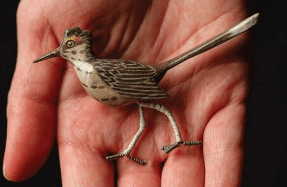A HOSTILE COUNTRY


IN THE EARLY DAYS OF OCTOBER 2020, a soft breeze blew across Cold Spring Mountain, rustling the sagebrush and aspen groves. Three prominent conservationists camped near the weathered land marker that identified the junction of Utah, Colorado and Wyoming, hoping to hear something that had long been absent from this landscape: the howling of a pack of wolves.
Karin Vardaman, who is widely recognized as one of the nation’s experts on wolves, was collecting data for the Working Circle, a nonprofit she founded that works to reduce conflicts between predators and livestock producers. That winter, a wolf pair and as many as four others were spotted in Moffat County, Colorado — the first pack of wolves documented in the state in more than 80 years. But within a few months, after they crossed the nearby border into Wyoming, three of them had been shot and killed, their deaths confirmed. Throughout that summer, wildlife biologists conducted howl surveys of the area to see if any of the others had survived. Vardaman, who had been tracking the pack, was a key part of those efforts.
“We were able to put together the pieces of the puzzle about how these wolves were using the landscape — where they were hunting, where their rendezvous spots were,” Vardaman told me by phone in May.
At the same time, Gary Skiba, a wildlife biologist who had worked for Colorado Parks and Wildlife for more than two decades, and Matt Barnes, a scientist for the Northern Rockies Conservation Cooperative, were searching for the pack along the Green River.
Wildlife scientists tend to be lone wolves themselves, with a strong protective streak; they often keep their findings and the locations of their cameras private, obscuring details, such as pack movements, so the wolves they’re tracking can’t be easily targeted. Vardaman had crossed paths with Skiba and Barnes before, however; the “wolf world” is a small place, as Skiba likes to say. Vardaman told them that she had heard howls in the area a few days earlier, so they all camped nearby, staying close together and hoping to hear them again. Vardaman recalls chatting with the others, sharing information, and then Barnes and Skiba went back to their campsite. They sat up drinking and discussing the landscape.
And then the howling began: At least three distinctive sorrowful peals, long and deep, carried along by the slight breeze — faint but unmistakable amid a chorus of higher-pitched yips from a pack of coyotes. It lasted scarcely more than a minute, but Skiba said it made his hackles rise. It was “primal,” Skiba told me. “It’s very emotional, a real connection to wildness and a connection to this bigger landscape. It’s a feeling of recognizing a system that’s functioning properly.”
In the world of wolf restoration, that feeling is exceedingly rare. Gray wolves are native to this part of northwestern Colorado. They once flourished across the Western United States, ranging the Rocky Mountains in numbers at least into the tens of thousands. But years of lucrative trapping — much of it government-sponsored — in the 19th and 20th centuries, followed by liberal hunting regulations and development and habitat loss, devastated the population, and constantly changing federal and state guidelines haven’t helped. Now there are only around 2,000 gray wolves in the Western U.S. outside of Alaska, and they reside almost exclusively in the Northern Rockies. Skiba, Vardaman and Barnes knew that the wolves they heard that night were among the only known wolves in Colorado — the few surviving members
You’re reading a preview, subscribe to read more.
Start your free 30 days





